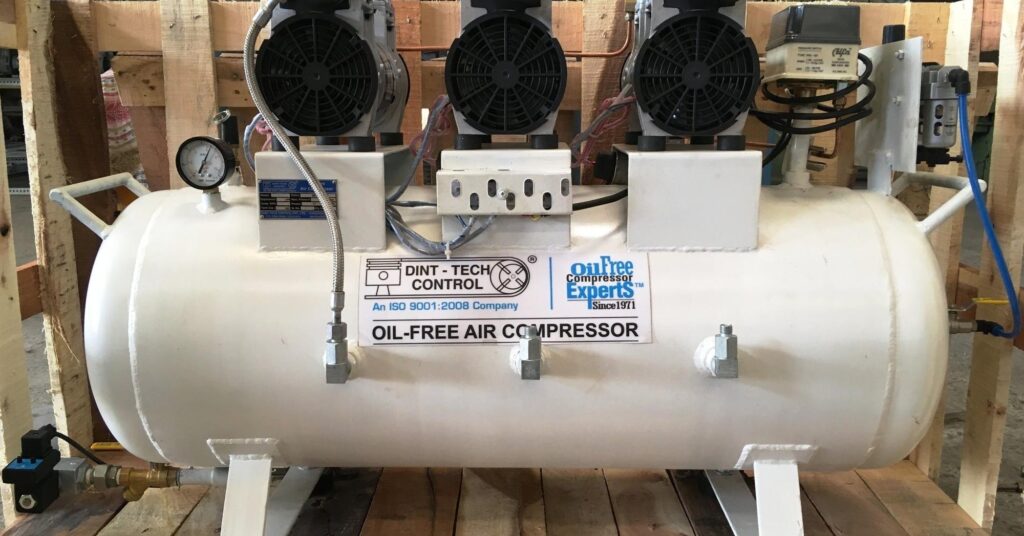Naturally, there is a large range of sizes and quality levels available for oil-free compressors, as well as a number of distinct technologies. These compressors play a wide range of functions in numerous industries. The quality of the air they produce is crucial, and their role is significant.
Oil free compressors are used in many industries, including electronics, food, medicine, and pharmaceuticals. Oil-free compressed air is essential in these sectors because the presence of oil may contaminate machinery, interfere with medical treatments, etc. in this blog we will tell you about the technology of oil free air compressor and the top oil free piston compressor suppliers.
Technology Behind Oil Free Air Compressor
The quality of compressed air depends on its purity. Exposure to oil makes it more expensive to maintain clean air. Many businesses favor oil-free industrial compressor manufacturers in order to allay this worry. Similar to an oil-injected compressor, an oil-free air compressor is lubricated without the use of oil.
Operational Procedures for Oil-Less Air Compressors
The best way to understand how oil-free air compressors operate and why they endure as long as they do is to go over each function step-by-step. Let’s take a look at how an oil-less air compressor operates and gives you the necessary compressed air.
Drawing in Air
To make sure the air is clean, oil-less air compressors begin by drawing in outside air through their unloader valve and putting it through an inlet air filter (or filters). The filter will prevent harm to the internal parts of your compressor. Usually, these filters are fine enough to exclude tiny particles of debris, dust, and dirt.
In order to help the compressor pump air into its chamber and put it in the loaded position, the unloader valve opens. The compressor starts operating in the unloaded state when the valve closes. Usually, your compressor will run out of air to draw in while it is actively delivering compressed air.
The low-pressure compressor element is where air goes first when your compressor turns on and begins to draw air through an open unloader valve.
Initial Compressor Part
It’s likely that you’ve noticed that your air compressor produces heat. This is typically caused by the low-pressure compressor element, which operates without oil.
The unit can run at a temperature of up to 180 degrees just by compressing air, and the typical compressor element will operate at about 2.5 bar. Because there isn’t a flowing medium to dissipate heat, that temperature can be more than twice as high as what oil-lubricated compressors can reach.
Access to the Intercooler
The air is first compressed and then allowed to cool in an intercooler before being compressed again by pistons. This step will either advance it to the second compression phase or the final one, depending on your particular compressor.
Heat produced during compression lowers the air’s oxygen content and lowers its density. When the air compressor is operating in conjunction with a combustion engine, cooling the air essentially serves as a straightforward way to enable denser and more oxygen-rich air to be utilized by the engine once more. This increases fuel supply and boosts power output.
There are two reasons intercoolers are necessary. To reduce the possibility of any heat-related damage, they first cool the air to the appropriate temperature. Second, two-stage pumps with intercoolers can compress air at significantly higher PSIs, which reduces wear on the second stage through the cooling process.
Air Preparation and Aftercooler Entry
The air will reach temperatures of about 150 degrees during its second compression phase, meaning it needs more cooling before it can be utilized in other equipment. Air that has completed its last stages of compression is sent to the aftercooler, where cooling enables appropriate storage.
Air will pass through a check valve on its way to the aftercooler that is meant to stop any backflow, allowing the air to continue to compress and fill your tank. Backflow will harm your apparatus and result in a significant air compressor failure.
Pulsation dampeners, which are installed in many compressors, particularly reciprocating compressors, are situated right before the aftercooler. When the air compressor uses suction and opens discharge valves, the dampener’s purpose is to lessen the pulsations and vibrations that result from this operation.
Pressure Transistor
Your air compressor tank’s detection equipment will keep track of how much air you have. The air compressor will restart and begin working to replenish the pressurized air in the tank when it drops below a predetermined level. The compressor is monitored and turned on and off via the pressure switch.
The unloader valve is usually connected to pressure switches, however occasionally the valve is internal. The factory sets the pressure switches, and they come at predetermined levels.
Benefits of Oil-Free Air Compressors
There are numerous benefits for users of oil-free compressors, including:
Reduced Upkeep
Compared to oil-injected compressed air, oil-free compressed air requires a great deal less maintenance. Regular oil changes are necessary for oil-filled compressors, and they can be costly. It also costs extra for users to properly dispose of used oil.
Manual oil changes are not necessary for oil-free compressors, though. Draining the tank after each use is the most important maintenance task. In comparison to oil-injected techniques, this action is less expensive and time-consuming.
Reduced Price
The cost of oil-free compressors is lower than that of oil-injected compressors. They are generally more affordable up front and have longer lifespans, so they are valuable investments. Because oil-free compressors have fewer parts, maintenance and replacement costs are lower. Certain model types come with energy-saving regulators that reduce fuel costs.
Friendliness Toward The Environment
Additionally, oil-free compressors leave little trace on the environment. Pollutants released into the atmosphere by oil-injected units have the potential to affect both the environment and workers. On the other hand, the absence of oil in oil-free models reduces environmental damage.
Conclusion
The most traditional and well-known type of compressor technology is oil-less. The idea behind oil-less piston compressors is the transformation of linear motion into rotational motion. The piston inside the cylinder moves up and down due to the motor turning the compression units.







